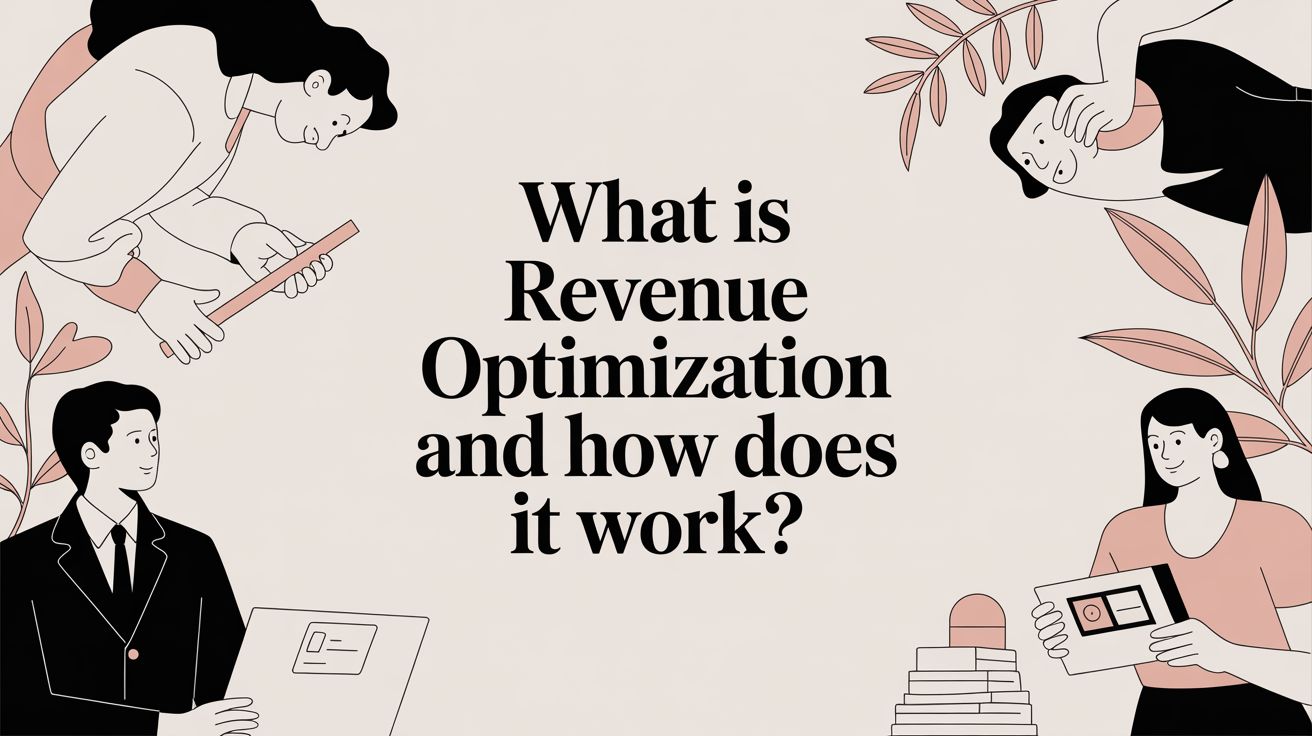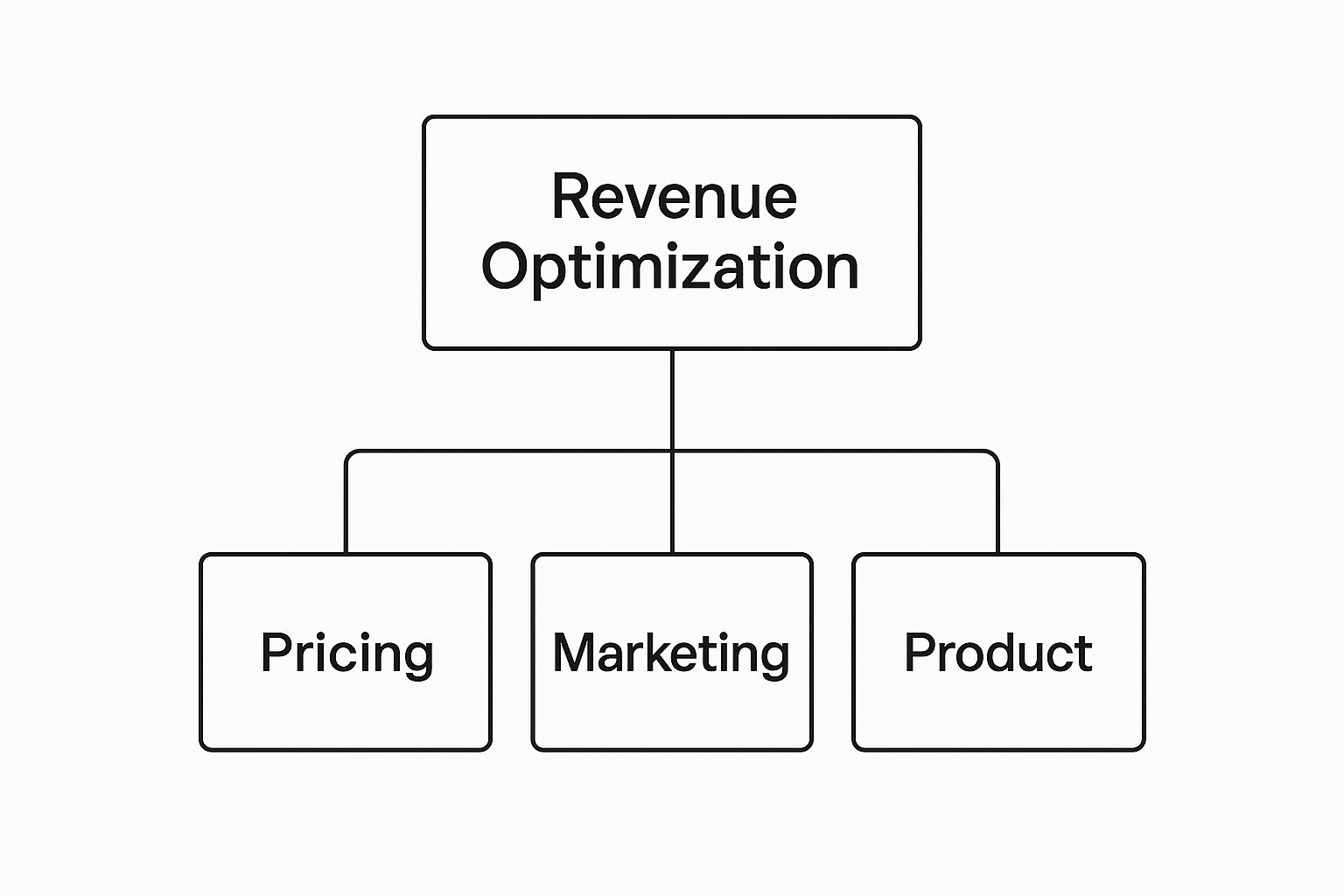
What Is Revenue Optimization and How Does It Work?
Discover what is revenue optimization and learn actionable strategies to align pricing, sales, and marketing for sustainable digital growth. Start today.
Let's get right to it: what exactly is revenue optimization?
At its core, it's the art and science of getting all your business functions—pricing, marketing, sales, and even product development—to work together with one goal in mind: maximizing the long-term profitability from every single customer. This isn't about quick cash grabs or just jacking up prices. It's about making smarter, data-driven decisions that create sustainable, predictable income growth.
A Holistic Approach to Business Growth
Think of your business like an orchestra. When the strings, brass, and percussion are all playing from different sheet music, you get noise. But when they're all in sync, led by a single conductor, you get a masterpiece. Revenue optimization is that conductor. It ensures every department is playing its part in a coordinated strategy to capture the most value possible.
This approach stops you from treating revenue as a guessing game. Instead, it pushes you to dig deep into customer behavior, market trends, and the real value of your product to answer the tough questions that actually drive growth.
The Four Pillars of Revenue Optimization
A solid revenue optimization strategy doesn't just happen; it's built on a few key pillars. Each one supports the others, creating a structure that's much stronger than any single tactic.

As the visual shows, optimization isn't one single action. It's the outcome of getting these crucial efforts in sync.
Revenue optimization is about selling the right product to the right customer at the right time for the right price through the right channel. It transforms guesswork into a calculated, predictable system for growth.
To bring this idea to life, consider this: instead of just slashing prices to boost sales numbers (a classic short-term move), an optimized strategy might lead you to create a new product tier. This new tier could attract a whole different type of customer—one who was never going to buy your main offering—without cheapening the value for your loyal, existing users.
It's this forward-thinking, integrated mindset that really sets revenue optimization apart. You're not just chasing customers; you're attracting the right ones and figuring out how to maximize their lifetime value. You're building a resilient, adaptable business that turns every customer interaction into an opportunity for smart, sustainable growth.
Mastering the Core Revenue Optimization Strategies

Getting your head around revenue optimization is one thing, but putting it into practice is what really counts. The good news is that the core strategies aren't some abstract academic theories; they are practical levers you can pull to directly boost your bottom line. By focusing on pricing, personalization, and your product mix, you can build a powerful and resilient revenue engine.
Each of these strategies hits a different part of the customer value puzzle. When they work together, you're able to capture the most possible revenue from your entire audience—not just one sliver of it. Let’s dig into how each one plays out in the real world.
Drive Growth with Intelligent Pricing
Intelligent pricing simply means moving past a one-price-fits-all mentality. Instead, you align your pricing with the actual value your customers get from your product. This is a fundamental part of revenue optimization because it tackles the most direct question: what is a customer truly willing to pay?
Streaming giants are a perfect case study. Their tiered subscription models are designed for exactly this. A basic plan with ads is there to catch price-sensitive folks who would otherwise never sign up. The standard HD plan hits the sweet spot for the average family, and a premium 4K option is there for enthusiasts who will happily pay more for the best quality.
This tiered approach lets one company serve multiple distinct market segments, maximizing both its reach and revenue. Rather than picking a single price and crossing their fingers, they create specific value propositions for different needs and budgets. It's a smart model for any business, and you can see how this thinking applies across different mobile app monetization strategies.
Connect with Customers Through Hyper-Personalization
This is where you use customer data to craft experiences that feel like they were made for just one person. Think of it as the difference between a generic "Dear Customer" email and an offer that's so specific and timely it feels like the company read your mind. This approach drives conversions because it connects with individual behaviors and needs.
A great example is an e-commerce site that remembers you. When you come back, it’s not just showing you a random assortment of bestsellers. It’s highlighting products you looked at last time, suggesting things that would go perfectly with them, and maybe even nudging you with a small discount on that item you left in your cart.
This level of personalization shifts the customer experience from passive browsing to an active, engaging conversation. It proves you understand them, which builds trust and makes a purchase feel like the natural next step.
Maximize Value with a Strategic Product Mix
Finally, a strategic product mix is all about increasing your average revenue per user (ARPU) by being smart about how you package and present what you sell. It’s not just about selling one-off products; it’s about creating clear opportunities for upselling and cross-selling.
Software-as-a-Service (SaaS) companies are absolute pros at this. You'll often see them use a "good, better, best" model to nudge users toward more valuable plans. Take a project management tool, for instance:
- Basic: Gives you the core features, perfect for an individual.
- Pro: Adds in team collaboration tools—a clear upsell for a growing business.
- Enterprise: Throws in advanced security and analytics, which are non-negotiable for large organizations.
By bundling features into these logical tiers, they create a natural upgrade path for customers. This doesn't just bump up today's revenue; it massively increases long-term customer lifetime value by allowing the product to grow alongside the customer's own needs. These three strategies—pricing, personalization, and product mix—are the bedrock of any successful revenue optimization effort.
Tracking the Metrics That Actually Matter
You can't optimize what you don't measure. But more importantly, you can't just measure everything. Effective revenue optimization isn’t about drowning in data; it’s about focusing on the numbers that tell the real story of your business's health.
Forget vanity metrics like raw traffic or total app downloads for a moment. To truly steer the ship, you need to look at the key performance indicators (KPIs) that directly connect to your revenue engine. These aren't just numbers on a dashboard—they're the vital signs of your company.

They don’t just tell you how you did last quarter. They give you the insights to make smarter decisions for the next one.
The Bedrock Metrics of Revenue Health
To get a clear picture of your financial performance, every business should start with a handful of non-negotiable metrics. Think of these as the foundation of your entire strategy. They provide a balanced view, showing you not just how much money is coming in, but how efficiently you're generating it.
Here are the essentials you absolutely must have a handle on:
- Customer Lifetime Value (CLV): This is the big one. It’s the total profit you can reasonably expect to make from a single customer over the entire time they do business with you. A rising CLV is a fantastic sign that your customers are sticking around and finding more value in what you offer.
- Customer Acquisition Cost (CAC): How much does it really cost to get a new customer in the door? CAC rolls up all your marketing and sales spend to give you a per-customer figure. The golden rule is simple: your CLV needs to be significantly higher than your CAC. If it's not, you're buying customers at a loss.
- Average Revenue Per User (ARPU): This gives you a quick snapshot of how much revenue each user is generating on average. It's calculated by dividing total revenue by the number of users, and it’s invaluable for understanding the immediate value of your user base and for forecasting.
Keeping a close eye on the relationship between these three metrics is what separates fast-growing companies from profitably growing ones.
The Canaries in the Coal Mine: Leading Indicators
While the foundational metrics tell you where you are right now, leading indicators give you a glimpse into the future. They act as an early warning system, flagging potential problems long before they blow a hole in your revenue reports.
Two of the most critical leading indicators are churn and conversion rates.
Churn Rate is the percentage of customers who cancel or stop paying for your service within a given period. It's a direct reflection of customer happiness and product-market fit. High churn is a leaky bucket that will sink even the best acquisition efforts.
Even a tiny improvement in your churn rate can have an outsized impact on long-term profitability.
On the other side of the coin is your Conversion Rate. This is the percentage of people who take a specific, desired action—like signing up for a trial, upgrading to a paid plan, or making an in-app purchase. Improving this metric is one of the most direct ways to squeeze more revenue out of the traffic you already have.
When you start tracking these numbers properly, you unlock a powerful diagnostic toolkit. It's no surprise that companies embracing sophisticated revenue intelligence strategies see incredible results. In fact, some have reported a 32% higher win rate and a 19% increase in revenue in the first year alone. You can dig deeper into these revenue intelligence findings to see the full picture.
Seeing Revenue Optimization in the Real World
All the theory in the world is great, but seeing revenue optimization in action is what makes the lightbulb go on. The ideas of segmenting customers, adjusting prices based on value, and personalizing offers aren't just academic concepts—they're the engines behind billions of dollars in revenue for companies that get them right.
To make this crystal clear, let's look at two industries that have practically built their business models on revenue optimization: telecommunications and digital publishing. Both have huge, diverse customer bases and complex products, making them perfect case studies.
Plugging Leaks in the Telecommunications Industry
The telecom industry is a true powerhouse of revenue optimization, mainly because it has to be. These companies are constantly juggling millions of subscribers, intricate billing systems, new customer acquisition, and the technical demands of things like 5G.
With such a massive volume of transactional data, they lean heavily on automation and analytics to reduce revenue leakage—that’s the money that simply vanishes due to billing errors or charges that were never captured. It's such a big deal that the telecom industry's slice of the revenue management solutions market is expected to hit 28.3% by 2025. You can get a sense of the scale by digging into these revenue management market trends.
By digging into usage patterns, telecom companies can:
- Pinpoint their high-value customers and proactively offer them deals to stick around.
- Bundle services like mobile, internet, and TV into packages that feel tailor-made.
- Get ahead of churn by spotting the early warning signs in a customer's behavior.
This goes way beyond just sending out a bill on time. It's about using data to get the absolute most value out of every single customer relationship, from day one until the very end.
The Dynamic Paywall: A Digital Publisher’s Masterclass
For a more focused example, you don't have to look any further than digital subscriptions. A publisher like The New York Times is giving a masterclass on how to use a dynamic paywall to fuel incredible subscriber growth. Their whole strategy is a brilliant exercise in revenue optimization.
Instead of a blunt, one-size-fits-all wall that blocks every non-subscriber, they use a metered system. A casual reader can check out a few free articles each month. This isn't just generosity; it serves a critical purpose by gathering data and sorting the audience into different buckets.
This strategy creates a natural funnel. It allows the publisher to distinguish between fleeting visitors and highly engaged, loyal readers who are prime candidates for a subscription offer.
The moment a reader hits their article limit, the paywall pops up. It’s a call to action timed to perfection, appearing at the exact moment the user has shown they really want the content. In effect, the publisher is using its own product to qualify leads and turn them into paying customers. This intelligent approach to access control is key to modern paywall design, and you can learn more about the different types of paywalls and their concepts.
These real-world examples show that revenue optimization isn't just some vague corporate buzzword. It's a set of tangible, data-backed strategies that produce real results by understanding what customers truly value and responding to it.
Using Data and AI to Make Smarter Decisions

If strategies like dynamic pricing and personalization are the engine of revenue optimization, then data and AI are the high-octane fuel that makes it run. In today's market, making big decisions based on gut feelings or old spreadsheets is like trying to navigate a new city with a paper map. Modern tools act as a strategic co-pilot, processing huge amounts of information to find the most profitable path forward.
Data analytics gives you the foundational insights, turning raw user activity into a clear picture of what your customers are doing and why. It answers the crucial "what" and "why" behind your revenue numbers. AI and machine learning then take things a big step further, using that data to predict what’s likely to happen next and recommend the best move.
From Reactive to Predictive Power
The real magic of using AI is shifting from making reactive adjustments to making predictive decisions. Instead of waiting for a user to hit the "cancel subscription" button, a smart system can spot the warning signs long before they decide to leave.
This predictive power opens up some game-changing possibilities:
- Churn Prediction: Algorithms can analyze subtle changes in how a user engages—like shorter session times or logging in less often—to flag customers who are at risk of churning. This gives you a chance to step in with a targeted retention offer before it’s too late.
- Optimal Offer Timing: AI can figure out the perfect moment to show a user an upsell or a trial extension. By understanding where someone is in their journey, it makes sure the offer feels helpful instead of pushy, which can dramatically improve conversion rates.
- Price Sensitivity Analysis: What’s the right price for each user? AI can analyze behavioral data to figure out the price elasticity for different customer groups, helping you find that sweet spot that maximizes both sign-ups and revenue.
This is how businesses move beyond one-size-fits-all strategies. It’s about crafting deeply personal customer journeys at scale by making millions of tiny, optimized decisions that add up to major revenue growth.
This is exactly why data-driven approaches are no longer a "nice-to-have." According to one report, over half of business leaders in high-tech and life sciences believe data analytics offers the biggest opportunity for improving revenue operations. You can see the full 2025 State of Revenue Report for more details.
A core part of this process is learning how to group users based on what they do. To see how this works in practice, you can explore our guide on defining customer segments and events. Technology isn't just an option anymore; it’s the essential tool for anyone serious about winning.
Common Questions About Revenue Optimization
As you start digging into revenue optimization, you'll probably find a few questions keep popping up. Let's tackle them head-on, clear up some common confusion, and get you on the right track.
Revenue Management vs Revenue Optimization
It's easy to use these terms interchangeably, but they're not quite the same thing. Think of revenue management as the tactical side of things—it's very focused on pricing and inventory. A classic example is an airline adjusting seat prices based on demand and timing. It's all about selling the right seat to the right person at the right moment.
Revenue optimization, on the other hand, is the bigger picture. It's a much broader strategy that pulls in marketing, sales, product development, and even customer support. The goal isn't just to nail the price for a single transaction; it's about maximizing long-term profitability and the lifetime value of every customer.
How Can Small Businesses Start Optimizing?
You don't need a huge budget or a team of data scientists to get started. Small businesses can make a huge impact by focusing on the fundamentals.
- Know Your Customers: Who are your best customers? What makes them stick around? Figure out what your most valuable segments look like.
- Take a Hard Look at Pricing: Is your pricing truly aligned with the value you provide? Sometimes you’re charging too little, and sometimes you’re charging for the wrong things.
- Track What Matters: Don't get lost in a sea of data. Start with the essentials, like Customer Acquisition Cost (CAC) and Customer Lifetime Value (CLV).
Even simple A/B tests on your pricing page or in-app offers can uncover some surprisingly powerful insights right from the get-go.
A lot of people think revenue optimization is just a fancy term for jacking up prices. That's a huge myth. It's really about finding the sweet spot—offering the right product to the right person at the right price to grow your total revenue.
This could mean introducing a lower-priced tier to capture a new audience, or it might involve bundling features to increase the average revenue per user. It's all about finding that perfect balance that fuels sustainable, long-term growth.
Ready to stop guessing and start optimizing your app's revenue? Nuxie helps you build, test, and deploy high-converting paywalls in minutes using AI. Discover how Nuxie can transform your monetization strategy.